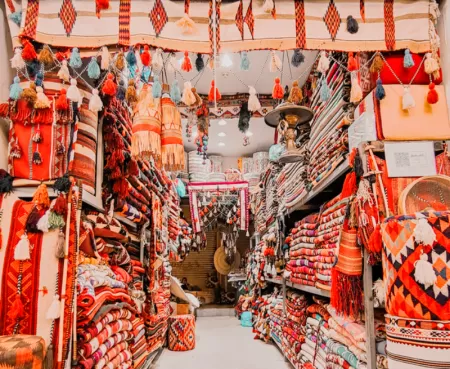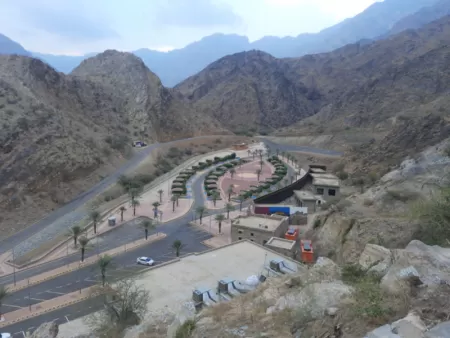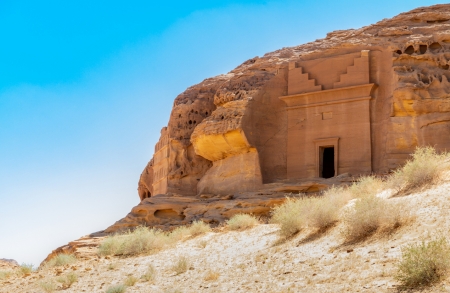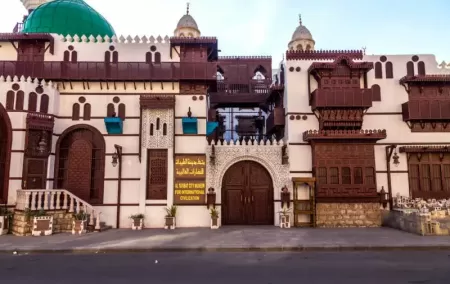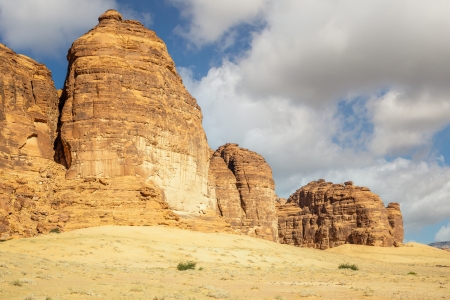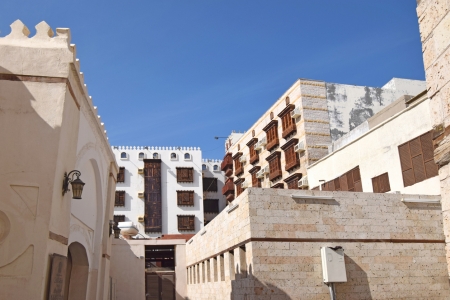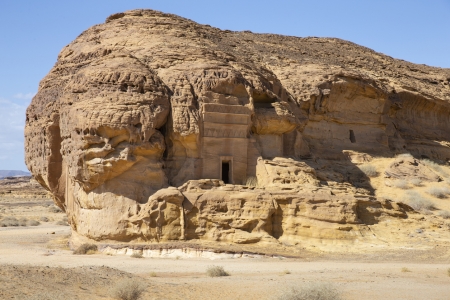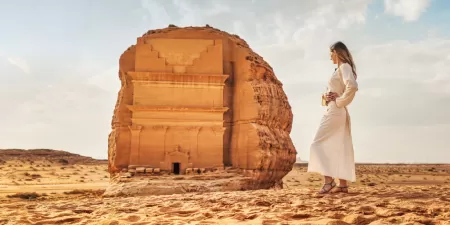Discovering the Ancient Kingdom of Dadan
Dadan is an ancient archaeological site located in AlUla, Saudi Arabia, known for being the capital of the Dadan and Lihyanite kingdoms between the 9th and 1st centuries BCE. The site features remarkably well-preserved rock-cut tombs carved into red sandstone cliffs, inscriptions, and remnants of an advanced ancient civilization. Dadan holds immense historical and cultural significance and is a key part of Saudi Arabia's Vision 2030 tourism initiative, drawing global interest for its deep-rooted heritage and unique desert landscapes.

The ancient city of Dadan, nestled in the heart of AlUla, Saudi Arabia, is a treasure trove of history waiting to be explored. This remarkable site, once the capital of the Dadanite and later the Lihyanite kingdoms, offers a glimpse into a sophisticated civilization that thrived in the region over two millennia ago. With its breathtaking landscapes, intricate tombs, and rich cultural heritage, Dadan is a must-visit destination for anyone embarking on Saudi Arabia tours.
The Historical Significance of Dadan:
The significance of Dadan in the historical narrative of Arabia cannot be overstated. Established around the 9th century BCE, Dadan served as a vital hub for trade and governance. The kingdom's strategic location along major trade routes allowed it to flourish economically, particularly through the trade of valuable commodities like frankincense. This aromatic resin, highly sought after in ancient times, was harvested from local trees and transported to distant markets, including those in the Mediterranean.
The Dadanite Kingdom:
The Dadanites were known for their advanced social structure and governance. The kingdom operated under a dynastic rule, which provided stability and order. Evidence suggests that both men and women had rights to property, a progressive trait for the time. The people of Dadan developed a unique writing system, known as Dadanitic, which was used for various purposes, including religious inscriptions and trade records.

The Dadanite Kingdom:
The Dadanites were known for their advanced social structure and governance. The kingdom operated under a dynastic rule, which provided stability and order. Evidence suggests that both men and women had rights to property, a progressive trait for the time. The people of Dadan developed a unique writing system, known as Dadanitic, which was used for various purposes, including religious inscriptions and trade records.
The Lihyanite Era:
Around the 5th century BCE, control of Dadan transitioned to the Lihyanites, who maintained many aspects of Dadanite culture. The Lihyanite period saw continued economic prosperity and the expansion of trade networks. During this time, the region became known for its artistic achievements, including intricate carvings and sculptures that adorned their tombs and religious sites.

Architectural Marvels of Dadan:
Dadan is home to some of the most impressive archaeological structures in Saudi Arabia. The tombs, carved into the sandstone cliffs, are particularly notable. Among them are the iconic lion tombs, which feature striking sculptures of lions that symbolize protection and power.
Tombs of the Lions:
The lion tombs are a testament to the artistry and engineering skills of the Dadanites. These magnificent structures are not only burial sites but also serve as a reflection of the social status of the individuals interred within them. The lions, carved with remarkable detail, stand guard over the entrances, evoking a sense of majesty and reverence.
Other Architectural Features:
In addition to the lion tombs, Dadan boasts various other architectural wonders. The site includes numerous chambers and sanctuaries that reveal the religious practices of the ancient inhabitants. Inscriptions and rock art found in these areas provide valuable insights into their beliefs and rituals.
The Archaeological Discoveries:
The ongoing archaeological efforts in Dadan continue to unveil new facets of this ancient civilization. The Dadan Archaeological Project, a collaboration between Saudi and French researchers, has unearthed a wealth of artifacts that shed light on the daily lives of the Dadanites.
Artifacts and Inscriptions:
Excavations have revealed a variety of artifacts, including pottery, tools, and decorative objects. These items illustrate the craftsmanship and artistic flair of the Dadanites. Inscriptions found on stone surfaces provide evidence of their language and offer glimpses into their social and economic activities.
The Role of Trade:
Trade played a crucial role in the prosperity of Dadan. The kingdom's location allowed it to control the flow of goods along the incense route, leading to significant wealth accumulation. The tolls imposed on passing traders contributed to the kingdom's economic stability, enabling the Dadanites to invest in their infrastructure and culture.
The Cultural Legacy of Dadan:
The cultural impact of Dadan extends far beyond its geographical boundaries. The artistic expressions, religious practices, and governance systems established by the Dadanites influenced neighboring regions and subsequent civilizations.
Artistic Expressions:
Dadanite artistry is characterized by its intricate carvings and sculptures. The skillful representation of human figures and animals in their art reflects a deep understanding of form and proportion. This artistic legacy continued to evolve during the Lihyanite period, showcasing the region's rich cultural heritage.
Religious Practices:
The religious beliefs of the Dadanites were complex and multifaceted. They worshipped a pantheon of deities, with Dhu Ghabat being one of the most significant. Temples and sanctuaries dedicated to these gods were integral to their society, serving as places of worship and community gathering.

Customize Your Dream Vacation!
Get in touch with our local experts for an unforgettable journey.
Plan Your Trip
Practical Information for Visitors:
When planning a trip to Dadan, it is essential to consider practical aspects such as transportation and accommodation. The region is well-connected, with various options for getting around. Visitors can choose from a range of accommodations, from luxury resorts to budget-friendly hotels, ensuring a comfortable stay.
The Future of Dadan:
As archaeological research continues, the future of Dadan looks promising. Ongoing excavations are expected to reveal even more about this fascinating civilization, enhancing our understanding of its history and cultural significance.
Preservation Efforts:
Efforts to preserve the archaeological site are crucial for maintaining its integrity for future generations. The Saudi government, in collaboration with international partners, is committed to protecting the cultural heritage of Dadan while promoting responsible tourism.
Educational Initiatives:
Educational programs aimed at raising awareness about the history of Dadan are also being developed. These initiatives seek to engage local communities and visitors, fostering a deeper appreciation for the region's rich cultural heritage.
Conclusion: A Journey Worth Taking:
Dadan stands as a testament to the ingenuity and resilience of ancient civilizations. Its rich history, stunning architecture, and cultural legacy make it a captivating destination for anyone interested in the history of Saudi Arabia. Whether you're embarking on Saudi tours or simply exploring the wonders of AlUla, a visit to Dadan promises to be an enlightening experience that will leave you in awe of the achievements of those who came before us.
FAQs:
1. What is the historical significance of Dadan in Saudi Arabia?
Dadan served as the capital of the Dadanite and Lihyanite kingdoms, playing a crucial role in ancient trade routes and cultural exchanges in the Arabian Peninsula.
2. How can I visit Dadan during my Saudi Arabia tour?
Visitors can access Dadan through guided tours arranged via the AlUla Visitor Centre, which provides transportation and informative experiences at the site.
3. Are there guided tours available at Dadan?
Yes, guided tours are available and recommended to enhance understanding of the site's historical and cultural context.
4. What are the Lion Tombs in Dadan?
The Lion Tombs are rock-cut tombs adorned with lion sculptures, symbolizing strength and protection, and are among the most notable features of Dadan's archaeological site.
5. When is the best time to visit Dadan?
The cooler months between October and April offer the most comfortable conditions for exploring Dadan and other outdoor sites in AlUla.
Don’t miss this wonder on your Saudi Arabia Tours - Book your Journey Now!





